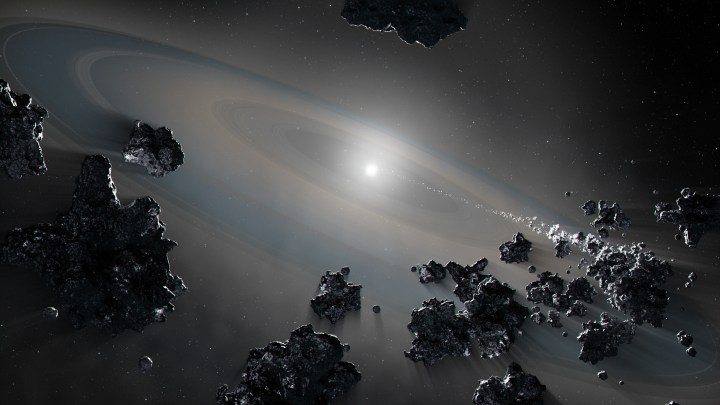When stars run out of fuel and come to the end of their lives, the biggest ones explode in huge supernovas. But smaller stars go through a different change in which they throw off portions of their mass, creating a planetary nebula around them and leaving a small, dense core called a white dwarf. Like the majority of stars, our sun will eventually become a white dwarf, glowing with residual heat but no longer producing energy through fusion.
Even though it is no longer active in terms of fusion, a white dwarf is still a formidable beast. Because the remnant of the star collapses down to a small core it is extremely dense, and the gravity of this core can wreak havoc on the objects around it. Recently, the Hubble Space Telescope uncovered a case of cosmic cannibalism, with a white dwarf consuming rocky and icy material from its surrounding environment.

The white dwarf, called G238-44, is the first one that has been observed accreting both rocky-metallic material and icy material, which is important as these are the key components from which planets are formed. Studying this white dwarf could therefore help researchers to learn about how planetary systems form.
Scientists know that when stars puff up to become red giants before shedding their mass and becoming white dwarfs, they dramatically impact any planets in their vicinity. And because the white dwarf studied by Hubble is pulling in matter related to planetary formation, including elements like nitrogen, oxygen, magnesium, silicon, and iron, the researchers can observe the mix of elements that would have gone into planets when they first formed.
In addition, the fact that the white dwarf is attracting icy bodies suggests that comets could be common in planetary systems, which supports the theory that water could have been brought to the early Earth by a comet or asteroid.
“Life as we know it requires a rocky planet covered with a variety of elements like carbon, nitrogen, and oxygen,” said one of the researchers, Benjamin Zuckerman, in a statement. “The abundances of the elements we see on this white dwarf appear to require both a rocky and a volatile-rich parent body – the first example we’ve found among studies of hundreds of white dwarfs.”
Editors' Recommendations
- See what James Webb and Hubble are observing right now with this tool
- James Webb Space Telescope celebrated on new stamps
- Hubble Space Telescope is back up and running following gyro problem
- Hubble Space Telescope is in safe mode due to a gyro problem
- Webb and Hubble work together to image the Christmas Tree Galaxy Cluster




